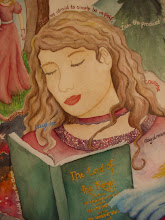 Everyone knows this classic story-- or do they? Thanks to a lot of Hollywood versions of Frankenstein, perhaps not. Read on! (Note: Please keep in mind that Frankenstein is the name of the doctor, not the actual monster that looks like this picture.)
Everyone knows this classic story-- or do they? Thanks to a lot of Hollywood versions of Frankenstein, perhaps not. Read on! (Note: Please keep in mind that Frankenstein is the name of the doctor, not the actual monster that looks like this picture.) 
Initially, this is a hard book to get into, even if you're used to the language typically used in classics. (I am, and this book's opening was still long and monotonous.) The story is begun by a man named Walton, the captain of an icebound ship sailing to the North Pole, who rescues a man from the frozen Arctic wasteland. The rescued man is named Dr. Victor Frankenstein, and he has a terrible story to tell. Victor Frankenstein starts out with a fairly happy, pleasant life until he begins to desire glory. His aspirations drive him more and more, and he craves knowledge. Eventually, he's built up the gall to create a sentient being: a monster made out of dead body parts, stitched and stapled together, and sparked into life by the power of electricity. Although Dr. Frankenstein wanted his creation to be handsome and human-looking, his monster is ugly. (This is partly because Dr. Frankenstein had to enlarge everything in the monster's body to a larger scale, because he was unable to put together something normally-sized-- some body parts are too small for that to have been possible.) Victor Frankenstein's dream of creating a superior, godlike race has failed, and he abandons his unattractive creation.
As Frankenstein's monster starts out trying to find his way in the world alone, thinking that humans are "divine beings," he tries very hard to improve himself so he can fit in. He learns the human languages, helping them "as if by an unseen hand," learning the history of mankind, and trying to make his voice sound less harsh. Frankenstein's creation does everything he can to be accepted, and wants someone to love him. He attempts to communicate with an old blind man, DeLacey, and since DeLacey can't see him, things go fairly well at first. Unfortunately, the blind man's children find him, and they beat him. The monster has been wronged by society, and begins to retaliate against the human race. He curses Dr. Frankenstein, and decides that since he has had to experience suffering, his creator should suffer also. The monster goes on a killing rampage and murders William, Victor's younger brother, and frames a servant for it. The servant is put to death by the law, even though she is actually innocent. Later, Frankenstein's monster kills Victor's bride Elizabeth, as well as his best friend, Henry Clerval, and haunts Victor wherever he goes. The monster is never accepted by society, and it makes him miserable and angry. Frankenstein also denies making the monster a mate, destroying his creation's dreams of happiness. Eventually both Dr. Frankenstein and his monster end up chasing one another to the Arctic region, where Victor is picked up by Walton's ship, and Frankenstein's monster goes further north. In these respective places, both eventually die-- alone, friendless, and far from the reaches of sanity.
Overall, this book isn't really about the Hollywood horror that people generally associate with Frankenstein. Instead, Mary Shelley has used various themes, including that of death, to illustrate her ideals and the development of society. Shelley believed that people were basically good until they were wronged by society, and she shows this view best in Frankenstein's monster. However, the main theme this book struggles to answer is: Who is the real evil-- Dr. Frankenstein, or his creation?

No comments:
Post a Comment